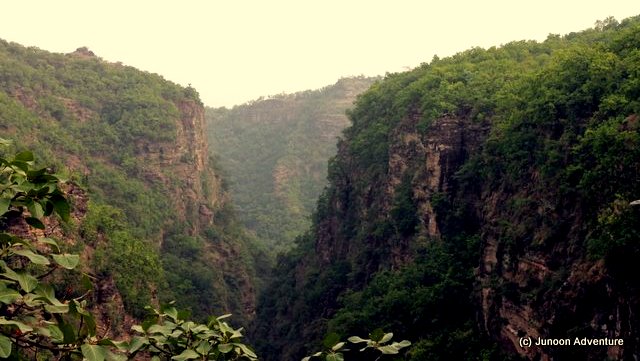My story with Junoon started seven years ago…
Road to Perdition Pachmarhi
It was back in the year 2012 in this very month – July – when I first crossed over my mental blocks and personal boundaries and decided to go on a trek to Pachmarhi with Junoon Adventure. It was the peak of monsoon, I remember it well. Hot, humid and unbelievably green. The drive from Pipariya to Pachmarhi is still firmly imprinted into my mind. Those winding lanes snaking through a deep, dark and dense forest (the first jungle I had ever seen!). Our gypsy passing by all those signboards on the way – tigers and flying squirrels and hornbills and leopards painted (albeit cartoonish-ly), telling us about whose territory it is that we are entering into. I remember feeling excited and thrilled. I remember feeling awed and slightly scared too.
I also remember feeling puzzled…
Amidst all those signboards, some welcomed us wholeheartedly into the land. One board called it Pachmarhi Wildlife Sanctuary, another welcomed us to the Satpura Biosphere Reserve and there were yet some more, calling the place Satpura National Park and Satpura Tiger Reserve. I remember reading them all as we zoomed past on the road to Pachmarhi and thinking – “Well, they all roughly mean the same thing.”
Pachmarhi wildlife sanctuary
Satpura National Park
Satpura Biosphere Reserve
Satpura Tiger Reserve –
पर्यायवाची शब्द? Maybe…
Anyways, the trek was amazing! we walked in a wild mango jungle, waded through the gurgling Denwa River, witnessed the ethereal geography of the Satpura Range, crawled through a 200ft cave and even managed to spot a Giant Squirrel in Pachmarhi’s forests. It was my first tryst with the wilderness, my first trek with Junoon, the first time I had ever set foot inside a forest and the beginning of a ‘way of life’ that has been with me for seven years and is expected to last a lifetime.
Interesting Rock Formations
Hidden Waterfalls
Awesome Greenery
Crawling through caves
Wading through the river
Tiger’s Pugmarks Spotted
That was 2012. This is seven years hence… All these years traveling in Madhya Pradesh, all those trips made to Pachmarhi, all those trekking tours in Satpura… Somehow the question has remained unanswered. My current trip to Pachmarhi is a recce – meant to finalise all the nitty gritties for our upcoming weekend trek to Pachmarhi. And even today, driving past all those signboards yet again for the umpteenth time, I am still puzzling over the same dilemma.
Pachmarhi – All Nature and No Network!
Hence no internet so whipping out my phone and googling the question was out of the question.
Tch, tch… what a pickle.
So sitting in the gypsy yet again, I decide to finally put the question to rest. Turning around to Yog sir, I piped up – “Wildlife sanctuary, national park, biosphere reserve – सब एक ही चीज़ हैं ना?”
And the look I got from the man – as if I had said that मेथी, बथुआ और पालक are all the same!
The rest of the drive was spent in silence. I knew I had committed some kind of cardinal sin. Even the gypsy driver was giving me looks. The silent treatment continued all the way to our hotel, where I was unceremoniously presented in front of my jury for the court martial. It was time to face the big guns – Chanakya Bhaiya.
So with a patient sigh and a subsequent smile, he sat us down in his office and said – “बेटा, पचमढ़ी आने वाला हर दूसरा व्यक्ति यही सोचता है|” And he went on to explain it all.
[ninja_tables id=”13162″]
Tiger Reserve
Tiger Reserves legally hold the status of Wildlife Sanctuaries/ National Parks, depending upon their initial constitution but are designated as Tiger Reserves owing to their nature of being breeding nuclei for tigers and are governed under Project Tiger, launched and managed by MoEF (Ministry of Environment and Forests). They are also managed under the core-buffer zone strategy wherein core zone is kept free from all human interference and activities, including livestock grazing and buffer zone is open to ‘conservation-oriented land use’.
From all that I could gather, Pachmarhi enjoys quadruple conservation status as on date. The place was declared as Pachmarhi Wildlife Sanctuary in 1977 for the protection of the many rare plant and animal species that exist within its forests. The Satpura National Park was established in 1981 and covers an area of 524km2 in the Hoshangabad District of Madhya Pradesh. In the year 1999-2000, the park acquired the status of being a Tiger Reserve and was henceforth, named the Bori-Satpura Tiger Reserve or the Satpura Tiger Reserve. And finally in the year 2009, the Satpura Tiger Reserve, combined with the Bori Wildlife Sanctuary and the Pachmarhi Wildlife Sanctuary, was named as the 4,926.28 km2 Satpura Biosphere Reserve by UNESCO under its Man and the Biosphere (MAB) Programme.
So much for making sense of this – यहाँ तो Same सब्जी में मेथी भी ,बथुआ भी और पालक भी!
The Satpura National Park serves as the Core Zone while the Bori Wildlife Sanctuary and the Pachmarhi Wildlife Sanctuary together constitute the Buffer Zone of the Reserve. The nearest human settlement is the hill town of Pachmarhi which happens to be inside the Core Zone of the reserve (wow!)
So does this ultra-high-importance nature and wildlife location in Madhya Pradesh – one that gets four times the legal protection and conservation efforts, really does deserve it? Well…
- The forests of Pachmarhi are made up of Teak, Sal, Tendu and Mahua trees and also have substantial numbers of wild mangoes, silver ferns, Jamun and Arjun trees.
- Animals found in and around Pachmarhi include tigers (the Holy Grail!), leopards, wild boars (saw a whole pack of these on a night drive with Chanakya Bhaiya and Yog sir near the airstrip once!), Gaur (saw one near Singhanama), Cheetals, Sambars, black bucks, Chausinghas, Chinkaras, Neelgais, Indian Wolves, Indian Giant Squirrels and Flying Squirrels.
- Fourteen rare ethno-botanical plant species also occur here that are used by local tribes for medicinal purposes.
- The Satpura Biosphere Reserve is also home to the Highest Peak in Central India – Dhoopgarh, standing tall at 1352mts.
- Pachmarhi is also home to many ancient cave paintings in the forests (most of which can only be reached after hours of trekking), some of which are estimated to be over 10000 years old!
All I can say now is, finally the mystery for me is solved!
To enjoy trekking in Pachmarhi or go on a wildlife spotting or Bird Watching Tour in Pachmarhi or to simply visit this beautiful hill-town and enjoy its natural beauty, call Shri Chanakya Bakhshi Ji at Hotel Misty Meadows, Pachmarhi on +91-9425310436 or Ms. Rupanjali Singh at +91-9479824975.
 AWAARGI – UNSEEN PACHMARHI
AWAARGI – UNSEEN PACHMARHI
26th to 28th July | Trekking and Caving



